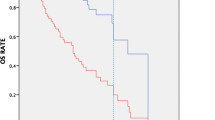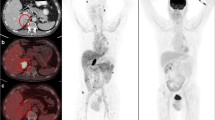Abstract
Purpose
We aimed to investigate the role of [68 Ga]Ga-FAPI-04 PET/CT and uptake patterns of primary and metastatic lesions in patients with renal cell carcinoma (RCC).
Methods
Twenty patients with a suspicious lesion considered primary renal malignancy or a history of RCC were included in our study. Two patients were excluded from further analyses due to other confirmed malignancies. Six patients were newly diagnosed, while the indication of 12 patients was restaging. All patients underwent [68 Ga]Ga-FAPI-04 and [18F]F-FDG PET/CT. SUVmax and tumor-to-background ratio (TBR) of primary (n = 7) and local recurrent lesions (n = 6) and lymph node (n = 26), lung (n = 32), bone (n = 5), and other metastases (n = 14) were compared between the two tracers.
Results
We detected 90 lesions in 18 patients with varying FAPI and FDG uptake values on both PET/CT. The median TBR of FAPI-PET/CT of all lesions was higher than TBR of FDG-PET/CT with statistically significance (5.6 vs. 2.1, p < 0.001). In primary and recurrent lesions, the median SUVmax, TBR, and tumor volume on FAPI-PET/CT were higher than FDG-PET/CT. The median SUVmax of lung lesions on FAPI-PET/CT was statistical significantly higher than FDG-SUVmax (3.8 vs. 1.8, p = 0.02). The median of FAPI-SUVmax on primary lesions was lower in the early stage based on TNM compared to the advanced stage. FAPI-SUVmax in 49% of all lesions were SUVmax ≥ 6, and 13% were SUVmax ≥ 10. In patient-based analyses, seven patients (39%) had at least one lesion with FAPI-SUVmax ≥ 10; 12 patients (67%) had at least one lesion with FAPI-SUVmax ≥ 6.
Conclusion
This study showed the potential utility of [68 Ga]Ga-FAPI-04 PET/CT showing promising results in RCC. We have presumed that FAPI-PET/CT may be performed for complementary imaging modality providing prognosis and possibility of theranostic application in selected patients.




Similar content being viewed by others
Data Availability
The datasets generated during and/or analyzed during the current study are available from the corresponding author on reasonable request.
References
Bukavina L, Bensalah K, Bray F, Carlo M, Challacombe B, Karam JA, et al. Epidemiology of renal cell carcinoma: 2022 Update. Eur Urol. 2022;82:529–42. https://doi.org/10.1016/j.eururo.2022.08.019.
Moch H, Amin MB, Berney DM, Compérat EM, Gill AJ, Hartmann A, et al. The 2022 world health organization classification of tumours of the urinary system and male genital organs-part a: renal, penile, and testicular tumours. Eur Urol. 2022;82:458–68. https://doi.org/10.1016/j.eururo.2022.06.016.
Sohlberg EM, Metzner TJ, Leppert JT. The harms of overdiagnosis and overtreatment in patients with small renal masses: a mini-review. Eur Urol Focus. 2019;5:943–5. https://doi.org/10.1016/j.euf.2019.03.006.
Ljungberg B, Albiges L, Abu-Ghanem Y, Bedke J, Capitanio U, Dabestani S, et al. European Association of Urology Guidelines on renal cell carcinoma: The 2022 Update. Eur Urol. 2022;82:399–410. https://doi.org/10.1016/j.eururo.2022.03.006.
Oflas M, Ozluk Y, Sanli O, Ozkan ZG, Kuyumcu S. 68Ga-PSMA Uptake patterns of clear cell renal carcinoma across different histopathological subtypes. Clin Nucl Med. 2022;47:e45–6. https://doi.org/10.1097/rlu.0000000000003814.
Has Simsek D, Civan C, Erdem S, Sanli Y. Complementary role of 68Ga-prostate-specific membrane antigen and 18F-FDG PET/CT for evaluation of metastases and treatment response in renal cell carcinoma. Clin Nucl Med. 2021;46:579–81. https://doi.org/10.1097/rlu.0000000000003590.
Verhoeff SR, van Es SC, Boon E, van Helden E, Angus L, Elias SG, et al. Lesion detection by [(89)Zr]Zr-DFO-girentuximab and [(18)F]FDG-PET/CT in patients with newly diagnosed metastatic renal cell carcinoma. Eur J Nucl Med Mol Imaging. 2019;46:1931–9. https://doi.org/10.1007/s00259-019-04358-9.
Parihar AS, Mhlanga J, Ronstrom C, Schmidt LR, Figenshau RS, Dehdashti F, et al. Diagnostic accuracy of (99m)Tc-Sestamibi SPECT/CT for characterization of solid renal masses. J Nucl Med. 2023;64:90–5. https://doi.org/10.2967/jnumed.122.264329.
Ma H, Shen G, Liu B, Yang Y, Ren P, Kuang A. Diagnostic performance of 18F-FDG PET or PET/CT in restaging renal cell carcinoma: a systematic review and meta-analysis. Nucl Med Commun. 2017;38:156–63. https://doi.org/10.1097/mnm.0000000000000618.
Takahashi M, Kume H, Koyama K, Nakagawa T, Fujimura T, Morikawa T, et al. Preoperative evaluation of renal cell carcinoma by using 18F-FDG PET/CT. Clin Nucl Med. 2015;40:936–40. https://doi.org/10.1097/rlu.0000000000000875.
Liu Y. The place of FDG PET/CT in renal cell carcinoma: value and limitations. Front Oncol. 2016;6:201. https://doi.org/10.3389/fonc.2016.00201.
Kratochwil C, Flechsig P, Lindner T, Abderrahim L, Altmann A, Mier W, et al. (68)Ga-FAPI PET/CT: Tracer uptake in 28 different kinds of cancer. J Nucl Med. 2019;60:801–5. https://doi.org/10.2967/jnumed.119.227967.
Kuyumcu S, Sanli Y, Subramaniam RM. Fibroblast-activated protein inhibitor PET/CT: cancer diagnosis and management. Front Oncol. 2021;11: 758958. https://doi.org/10.3389/fonc.2021.758958.
Kuyumcu S, Kovan B, Sanli Y, Buyukkaya F, Has Simsek D, Özkan ZG, et al. Safety of fibroblast activation protein-targeted radionuclide therapy by a low-dose dosimetric approach using 177Lu-FAPI04. Clin Nucl Med. 2021;46:641–6. https://doi.org/10.1097/rlu.0000000000003667.
Giesel FL, Kratochwil C, Lindner T, Marschalek MM, Loktev A, Lehnert W, et al. (68)Ga-FAPI PET/CT: biodistribution and preliminary dosimetry estimate of 2 DOTA-containing FAP-targeting agents in patients with various cancers. J Nucl Med. 2019;60:386–92. https://doi.org/10.2967/jnumed.118.215913.
Solano-Iturri JD, Errarte P, Etxezarraga MC, Echevarria E, Angulo J, López JI, et al. Altered tissue and plasma levels of fibroblast activation protein-α (FAP) in renal tumours. Cancers (Basel). 2020;12. https://doi.org/10.3390/cancers12113393.
Yang J, Dong A, Zuo C. 68Ga-FAPI-04 PET/CT in solitary choroid plexus metastasis from renal cell carcinoma. Clin Nucl Med. 2022;47:885–7. https://doi.org/10.1097/rlu.0000000000004207.
Civan C, Isik EG, Karadogan S, Sanli Y, Kuyumcu S. 68Ga-FAPI-04 PET/CT and 18F-FDG PET/CT in metastatic papillary renal cell cancer. Clin Nucl Med. 2023. https://doi.org/10.1097/rlu.0000000000004587.
Xie F, Fu L, Zhou W. Superiority of 68Ga-FAPI-04 in delineation of soft tissue and liver metastases in chromophobe renal cell carcinoma for restaging. Clin Nucl Med. 2022;47:e758–9. https://doi.org/10.1097/rlu.0000000000004374.
Boellaard R, Delgado-Bolton R, Oyen WJ, Giammarile F, Tatsch K, Eschner W, et al. FDG PET/CT: EANM procedure guidelines for tumour imaging: version 2.0. Eur J Nucl Med Mol Imaging. 2015;42:328–54. https://doi.org/10.1007/s00259-014-2961-x.
Zhong X, Guo J, Han X, Wu W, Yang R, Zhang J, et al. Synthesis and preclinical evaluation of a novel FAPI-04 dimer for cancer theranostics. Mol Pharm. 2023;20:2402–14. https://doi.org/10.1021/acs.molpharmaceut.2c00965.
Liu X, Liu H, Gao C, Zeng W. Comparison of (68)Ga-FAPI and (18)F-FDG PET/CT for the diagnosis of primary and metastatic lesions in abdominal and pelvic malignancies: a systematic review and meta-analysis. Front Oncol. 2023;13:1093861. https://doi.org/10.3389/fonc.2023.1093861.
Dong A, Yang B, Bai Y, Zuo C. 68 Ga-FAPI-04 PET/CT in a small sarcomatoid renal cell carcinoma with widespread metastases. Clin Nucl Med. 2023;48:457–9. https://doi.org/10.1097/rlu.0000000000004607.
Çermik TF, Ergül N, Yılmaz B, Mercanoğlu G. Tumor imaging with 68Ga-DOTA-FAPI-04 PET/CT: comparison with 18F-FDG PET/CT in 22 different cancer types. Clin Nucl Med. 2022;47:e333–9. https://doi.org/10.1097/rlu.0000000000004073.
Zheng S, Lin R, Chen S, Zheng J, Lin Z, Zhang Y, et al. Characterization of the benign lesions with increased (68)Ga-FAPI-04 uptake in PET/CT. Ann Nucl Med. 2021;35:1312–20. https://doi.org/10.1007/s12149-021-01673-w.
Civan C, Isik EG, Has Simsek D, Buyukkaya F, Kuyumcu S. Utility of 68 Ga-FAPI-04 PET/CT in adenoid cystic carcinoma compared with 18 F-FDG PET/CT : two case reports. Clin Nucl Med. 2023;48:e350–2. https://doi.org/10.1097/rlu.0000000000004687.
Karivedu V, Jain AL, Eluvathingal TJ, Sidana A. Role of positron emission tomography imaging in metabolically active renal cell carcinoma. Curr Urol Rep. 2019;20:56. https://doi.org/10.1007/s11934-019-0932-2.
Nakamoto Y, Ishimori T, Shimizu Y, Sano K, Togashi K. Clinical utility of (68)Ga-DOTATOC positron emission tomography/computed tomography for recurrent renal cell carcinoma. Eur J Nucl Med Mol Imaging. 2019;46:1524–30. https://doi.org/10.1007/s00259-019-04298-4.
Evangelista L, Zattoni F, Alongi P. (68)Ga-dotatoc vs. (18)F-FDG vs. radiolabelled PSMA PET/CT in renal cancer patients. Ann Transl Med. 2019;7:S150. https://doi.org/10.21037/atm.2019.06.28.
Tariq A, Kwok M, Pearce A, Rhee H, Kyle S, Marsh P, et al. The role of dual tracer PSMA and FDG PET/CT in renal cell carcinoma (RCC) compared to conventional imaging: a multi-institutional case series with intra-individual comparison. Urol Oncol. 2022;40:66.e1-.e9. https://doi.org/10.1016/j.urolonc.2021.11.006.
Udovicich C, Callahan J, Bressel M, Ong WL, Perera M, Tran B, et al. Impact of prostate-specific membrane antigen positron emission tomography/computed tomography in the management of oligometastatic renal cell carcinoma. Eur Urol Open Sci. 2022;44:60–8. https://doi.org/10.1016/j.euros.2022.08.001.
Bentestuen M, Al-Obaydi N, Zacho HD. FAPI-avid nonmalignant PET/CT findings: an expedited systematic review. Semin Nucl Med. 2023. https://doi.org/10.1053/j.semnuclmed.2023.02.001.
Dong A, Yang Q, Hua M, Cheng C, Zuo C. Lipid-poor renal angiomyolipoma mimicking renal cell carcinoma on 68 Ga-FAPI-04 PET/CT. Clin Nucl Med. 2022;47:991–3. https://doi.org/10.1097/rlu.0000000000004297.
Qin C, Gai Y, Liu Q, Shao F, Lan X. Elevated 68Ga-FAPI accumulation in a recurrent angiomyolipoma. Clin Nucl Med. 2020;45:1034–5. https://doi.org/10.1097/rlu.0000000000003345.
Dell’Aprovitola N, Guarino S, Del Vecchio W, Camera L, Chiancone F, Imbimbo C, et al. Xanthogranulomatous pyelonephritis mimicking a renal cell carcinoma: a unique and challenging case. Acta Radiol Short Rep. 2014;3:2047981613513763. https://doi.org/10.1177/2047981613513763.
Joshi P, Lele V, Shah H. Fluorodeoxyglucose positron emission tomography-computed tomography findings in a case of xanthogranulomatous pyelonephritis. Indian J Nucl Med. 2013;28:49–50. https://doi.org/10.4103/0972-3919.116809.
Fendler WP, Pabst KM, Kessler L, Fragoso Costa P, Ferdinandus J, Weber M, et al. Safety and efficacy of 90Y-FAPI-46 radioligand therapy in patients with advanced sarcoma and other cancer entities. Clin Cancer Res. 2022;28:4346–53. https://doi.org/10.1158/1078-0432.Ccr-22-1432.
Hirmas N, Hamacher R, Sraieb M, Ingenwerth M, Kessler L, Pabst KM, et al. Fibroblast-activation protein PET and histopathology in a single-center database of 324 patients and 21 tumor entities. J Nucl Med. 2023;64:711–6. https://doi.org/10.2967/jnumed.122.264689.
Author information
Authors and Affiliations
Corresponding author
Ethics declarations
Ethical approval
All procedures performed in studies involving human participants were in accordance with the ethical standards of the institutional and/or national research committee and with the 1964 Helsinki Declaration and its later amendments or comparable ethical standards.
Informed consent
Informed consent was obtained from all individuals participants included in the study.
Conflict of interest
The authors declare no competing interests.
Additional information
Publisher's Note
Springer Nature remains neutral with regard to jurisdictional claims in published maps and institutional affiliations.
Rights and permissions
Springer Nature or its licensor (e.g. a society or other partner) holds exclusive rights to this article under a publishing agreement with the author(s) or other rightsholder(s); author self-archiving of the accepted manuscript version of this article is solely governed by the terms of such publishing agreement and applicable law.
About this article
Cite this article
Civan, C., Kuyumcu, S., Has Simsek, D. et al. The role of [68 Ga]Ga-FAPI-04 PET/CT in renal cell carcinoma: a preliminary study. Eur J Nucl Med Mol Imaging 51, 852–861 (2024). https://doi.org/10.1007/s00259-023-06461-4
Received:
Accepted:
Published:
Issue Date:
DOI: https://doi.org/10.1007/s00259-023-06461-4




